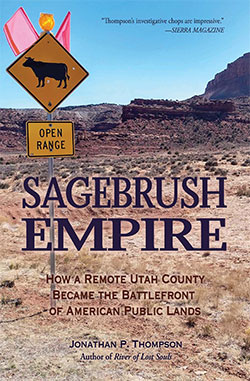One word might come to mind as you read Sagebrush Empire, Jonathan P. Thompson’s fascinating analysis of the cultural and political battles in Utah’s San Juan County.
 That word is mine. Not mine as in uranium mining, but mine like a two-year-old grabbing a toy from a big brother. Mine, mine, mine, mine, mine.
That word is mine. Not mine as in uranium mining, but mine like a two-year-old grabbing a toy from a big brother. Mine, mine, mine, mine, mine.
Everybody’s got a claim, as the ongoing, multi-layered fight over the Bears Ears National Monument demonstrates.
Who has a right to land? Who gets to build a road? Who has a right to put up a fence? Who determines what needs protecting? What are those protections designed to guard against? Who is enforcing those protections? Can’t we all, to coin a phrase, just get along?
Thompson starts with a perfect case, an emblematic moment that you might think would be chalked up to innocent mistake but somehow turned into a nasty legal showdown between a cattle rancher and a couple of visitors passing through San Juan County. They closed a gate! Was it malicious? Was it intentional? In our hair-trigger nation, the accusations flew. So did the lawsuits. Over, yes, a gate.
San Juan County is Thompson’s microcosm for all the “sagebrush rebellion” battles across the western United States. It’s a county he knows intimately. Originally from Durango, Thompson had explored San Juan County with family and friends on a fairly relentless basis since he was a youth. “I grew up on the Colorado side of the line,” he writes. “But I was brought up as a resident of the entire region, state lines be damned.”
As Thompson did with River of Lost Souls, his account of the 2015 Gold King disaster above Silverton, he turns Sagebrush Empire into a mix of history, personal adventure, reporting, and straight-up commentary. The book is a mosaic. Thompson details the Mormon expansion to southwest Utah, along with the harrowing journey down the 1,000-foot drop known as Hole-in-the-Rock and across the Colorado River. He writes about the legal complexities of pothunting and Kit Carson’s reign of terror against Native American tribes. Thompson layers background and history with tales of his own journeys across the land – harrowing hikes and a rafting trip through wind and dust storms on the San Juan River, often told with a great deal of self-deprecating humor. The history sections are a snap to follow, the adventures are a blast to read. We see both the rugged beauty and all the impacted layers of politics and attitudes that have come to bear on the county.
Everywhere he turns, Thompson finds people who are oppressed—or feel oppressed, victimized, hampered, and hindered by rules, signs, roads, fences, regulations, or the big old bad bureaucrats in Washington, D.C. Complaints are as common as dusty roads. And, no surprise, debates rage within factions over the appropriate tactics for fighting back. Thompson takes us up close and personal on a hair-raising protest as ATVs roar across precious, sacred Native American grounds. And he takes us into the thicket of local politics as some in San Juan County link arms with Cliven Bundy, the notorious “rebel” who chooses to believe that the federal government lacks the authority to manage BLM land and who would rather point guns at authorities than pay a modest grazing fee.
“The folks of San Juan County have been in backlash mode nearly since the day that the Hole-in -the-Rock expedition arrived in 1880,” writes Thompson. “They lashed back at the land that beat and battered them and washed out their crops and ditches; they lashed back when the feds tried to turn the county into a reservation for the Utes and when thousands of greedy Gentiles descended on the place in order to get at the gold in the river’s banks; they lashed back at forest reserves, at national monuments, at grazing restrictions, at road closures, at environmental policies. The sagebrush rebellion, a reactionary, backlashing movement by definition, constantly has raged in this little corner of Canyon Country for well over a century.”
In early October, President Biden announced that he was restoring the original 1.36 million acres of Bears Ears National Monument, reversing President Trump’s order to scale it back by 85 percent. If you just finished reading Sagebrush Empire when that news broke, as I did, you would know that this announcement does nothing to end the debates or lower tensions. Not hardly.
Mark Stevens is the author of The Allison Coil Mystery Series. Book three in the series, Trapline, won the Colorado Book Award for Best Mystery. Stevens also hosts the Rocky Mountain Writer podcast for Rocky Mountain Fiction Writers. He lives in Mancos, Colo.

